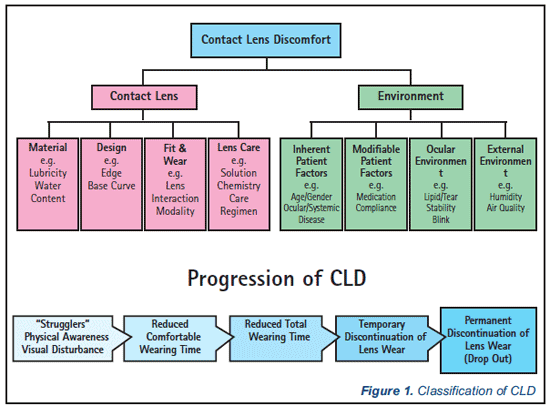








 |
DEFINITION AND CLASSIFICATION OF CLD
While clinicians practicing in the area of contact lenses all are familiar with CLD, a variety of terms and verbiage have been used to describe this problem. Typically these patients present with symptoms of ocular discomfort of some sort (e.g., dryness, irritation, discomfort, fatigue, and so forth), and it is commonthat these symptoms usually increase over the day while the patient is wearing the contact lenses. However, beyond this, no standard definition has been agreed upon globally with consensus as to what this problem is. As such, the definition of ‘‘CLD’’ is the following:
Contact lens discomfort is a condition characterized by episodic or persistent adverse ocular sensations related to lens wear, either with or without visual disturbance, resulting from reduced compatibility between the contact lens and the ocular environment, which can lead to decreased wearing time and discontinuation of contact lens wear.
The CLD Workshop membership characterized each of the terms in the definition, considering many other concepts in the development of the final definition. The rationale for the specific terminology included in the definition, and related terminology, can be found detailed in this subcommittee report. However, it is important to note that the CLD Workshop recognizes that CLD occurs while a contact lens is worn, and that the removal of contact lenses mitigates the condition (in particular the adverse ocular sensations). However, CLD is a condition that occurs after the initial ‘‘adaptation’’ period a neophyte goes through when first adjusting to contact lens wear. Physical signs may, or may not, be present in accompanying the adverse ocular sensations. Moving forward, the condition should be recognized as noted above, and the terms ‘‘contact lens dry eye’’ or ‘‘contact lens– related dry eye’’ should not be used when talking about contact lens discomfort. These terms should be reserved for an individual who has a preexisting dry eye condition, which may or may not be exaggerated when contact lenses are worn. Contact lens dropout refers to discontinuation of contact lens wear for a sustained period of time.
Classification of CLD was challenging, as classifying a disease relates to the ability to categorize it based on knowledge of the etiology. In addition, to our knowledge there has not been a previous classification scheme, and an understanding of etiologic factors has been identified in the other subcommittee reports as significantly lacking for CLD. The CLD Workshop felt that the two major categories of CLD were the contact lens and the environment (Fig. 1). The contact lens category was divided further into four subcatego- ries: material, design, fit and wear, and lens care. The environment category also was broken down further into four subcategories: inherent patient factors, modifiable patient factors, ocular environment, and external environment. Details of each of these subcategories can be found within the Definition and Classification Report.
Lastly, very little is agreed upon regarding the temporal progression of CLD, as this relates to contact lens dropout (or permanent cessation of contact lens wear). As such, the modes of progression also are presented in Figure 1, showing the temporal progression of CLD as patients begin to struggle, which is followed by the adoption of management strategies (e.g., reducing wearing time), and ultimately by contact lens dropout.

|















